Arthrosis of the hip joint is a degenerative-dystrophic pathology, characterized by the destruction of hyaline cartilage.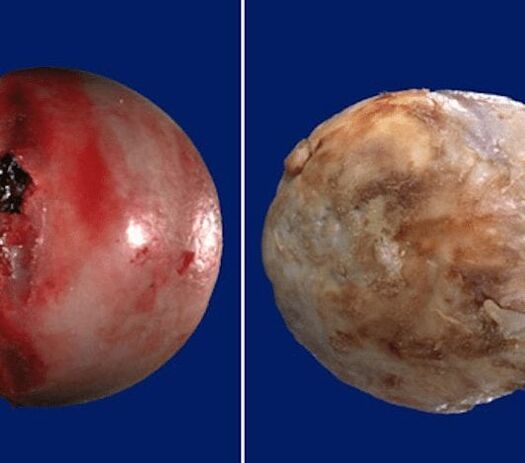 The disease develops gradually, accompanied by pain and reduced mobility. In the absence of medical intervention in the initial phase of osteoarthritis, after a few years, atrophy of the femoral muscles occurs.
The disease develops gradually, accompanied by pain and reduced mobility. In the absence of medical intervention in the initial phase of osteoarthritis, after a few years, atrophy of the femoral muscles occurs.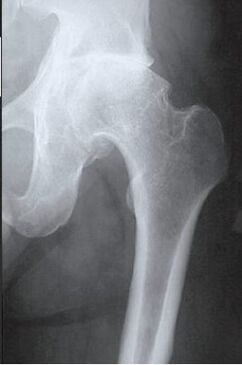 The injured limb is shortened and the fusion of the joint space leads to partial or complete immobilization of the hip joint. The causes of the pathology are previous injuries, curvature of the spine, systemic diseases of the musculoskeletal system.
The injured limb is shortened and the fusion of the joint space leads to partial or complete immobilization of the hip joint. The causes of the pathology are previous injuries, curvature of the spine, systemic diseases of the musculoskeletal system.
Osteoarthritis is usually detected in middle-aged and elderly patients. Diagnosis is made on the basis of the results of instrumental studies: radiography, MRI, CT, arthroscopy. Treatment of pathology of 1 and 2 degrees of severity is conservative. If ankylosis is detected or drug therapy is ineffective, a surgical operation (arthrodesis, endoprosthesis) is performed.
The mechanism of development of the pathology
The hip joint is made up of two bones: the ileum and the femur. The lower part of the ileum is represented by its body, which participates in the joint with the femur, forming the upper part of the acetabulum. During movement, the glenoid fossa is immobile and the femoral head moves freely. Such a "hinge" device of the hip joint allows you to bend, bend, rotate, promote abduction, adduction of the hip. The smooth, elastic and resilient hyaline cartilage that lines the acetabulum and the femoral head provides unhindered gliding of the joint structures. Its main functions are the redistribution of loads during movement, the prevention of rapid wear of bone tissues.
Under the influence of external or internal factors, the trophism of the cartilage is disturbed. It does not have its own circulatory system: synovial fluid supplies the tissue with nutrients. With osteoarthritis, it thickens, becomes viscous.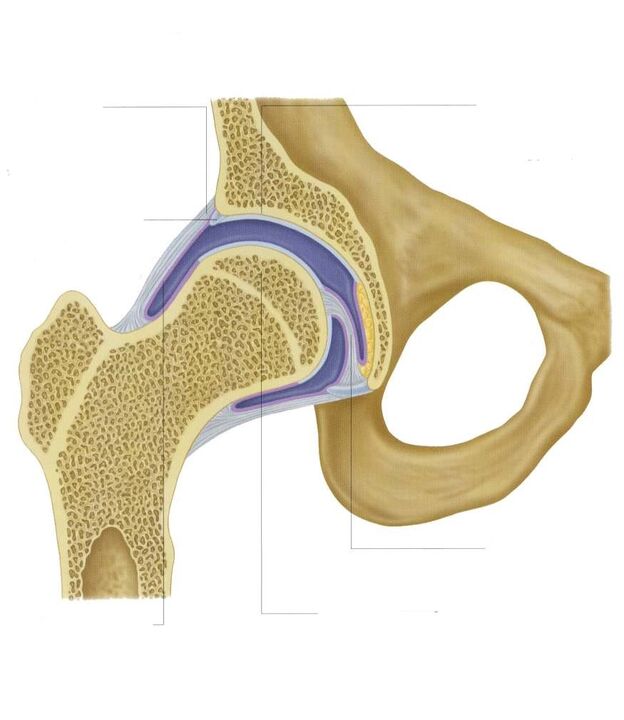 The resulting nutrient deficiency causes the surface of the hyaline cartilage to dry out. It becomes covered with cracks, which lead to permanent microtrauma of the tissues when flexing or extending the hip joint. The cartilage becomes thinner and loses its cushioning properties. Bones are deformed to "adjust" to increased pressure. And against the background of the deterioration of metabolism in tissues, destructive and degenerative changes progress.
The resulting nutrient deficiency causes the surface of the hyaline cartilage to dry out. It becomes covered with cracks, which lead to permanent microtrauma of the tissues when flexing or extending the hip joint. The cartilage becomes thinner and loses its cushioning properties. Bones are deformed to "adjust" to increased pressure. And against the background of the deterioration of metabolism in tissues, destructive and degenerative changes progress.
Causes and provoking factors
Idiopathic or primary osteoarthritis develops for no reason. It is believed that the destruction of cartilage tissue occurs due to the natural aging of the body, slowing down the recovery processes, a decrease in the production of collagen and other compounds necessary for the complete regeneration of the structures of the hip joint. Secondary osteoarthritis occurs against the background of a pathological condition already present in the body. The most common causes of secondary disease include:
- previous injuries: damage to the ligamentous tendon apparatus, muscle ruptures, their complete separation from the bone base, fractures, dislocations;
- violation of the development of the joint, congenital dysplastic disorders;
- autoimmune pathologies - rheumatoid, reactive, psoriatic arthritis, systemic lupus erythematosus;
- nonspecific inflammatory diseases such as purulent arthritis;
- specific infections - gonorrhea, syphilis, brucellosis, ureaplasmosis, trichomoniasis, tuberculosis, osteomyelitis, encephalitis;
- disruption of the functioning of the endocrine system;
- degenerative-dystrophic pathologies - osteochondropathy of the femoral head, osteochondritis dissecans;
- hypermobility of the joints, due to the production of "super-extensible" collagen, causing their excessive mobility, weakness of the ligaments.
Since the cause of the development of arthrosis can be hemarthrosis (hemorrhage in the cavity of the hip joint), provoking factors include disorders of hematopoiesis. Prerequisites for the onset of the disease are excess weight, excessive physical activity, a sedentary lifestyle. Its development is caused by an incorrect organization of sports training, a deficiency in the diet of foods with a high content of microelements, fat-soluble and water-soluble vitamins. Postoperative osteoarthritis occurs several years after surgery, especially if accompanied by the removal of a large amount of tissue. Trophism of hyaline cartilage is upset by frequent hypothermia, living in an environmentally unfavorable environment and working with toxic substances.
Osteoarthritis of the hip joint cannot be inherited. But in the presence of some congenital features (metabolic disorders, skeletal structure), the probability of its development increases significantly.
Symptoms
The main symptoms of osteoarthritis of the hip joint are pain when walking in the hip region, which radiates to the groin, knee joint. A person suffers from stiffness of movements, stiffness, especially in the morning. To stabilize the joint, the patient begins to limp, his gait changes. Over time, due to muscle atrophy and deformation of the joint, the limb shortens noticeably. Another characteristic sign of the pathology is the limitation of hip abduction. For example, difficulties arise when trying to sit on a stool with legs apart.
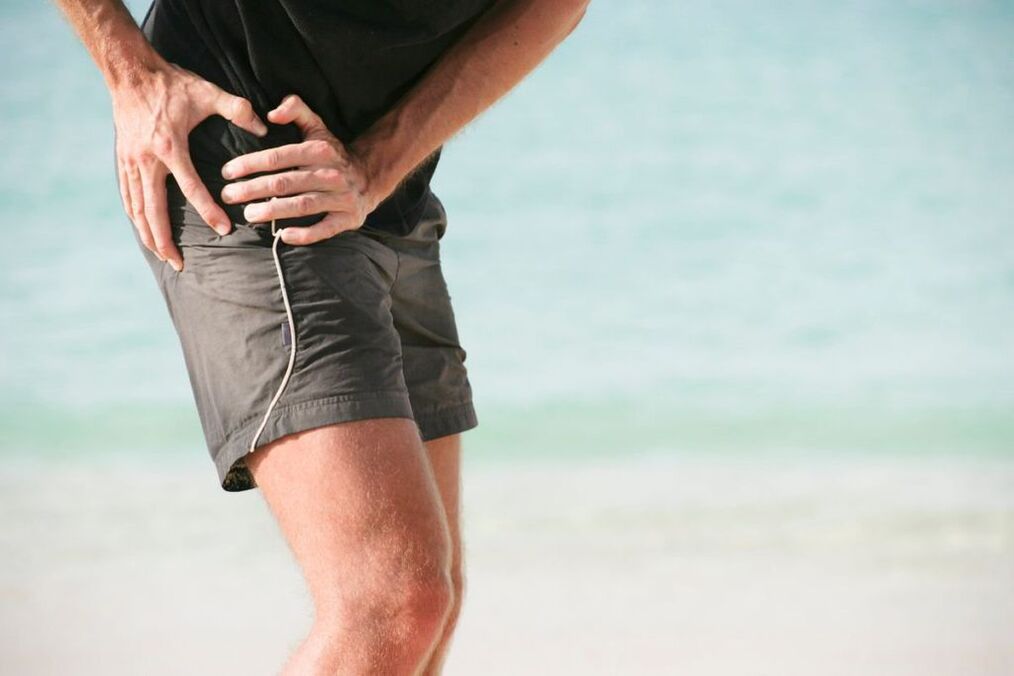
For osteoarthritis of the first severity, periodic pain occurs after intense physical exertion. They are localized in the area of the joint and disappear after a long rest.
With osteoarthritis of the second degree of the hip joint, the severity of the pain syndrome increases. Discomfort also manifests itself at rest, extends to the thigh and groin, increases with weight lifting or increased motor activity. To eliminate pain in the hip joint, a person begins to limp barely noticeably. Limitation of movement in the joint is noted, especially during abduction and internal rotation of the thigh.
Third degree osteoarthritis is characterized by constant severe pain that does not subside during the day and night. Difficulties arise when moving, therefore, when walking, a person is forced to use a cane or crutches. The hip joint is stiff, there is significant atrophy of the muscles of the buttocks, thighs and legs. Due to the weakness of the femoral abductor muscles, the pelvic bones are displaced in the frontal plane. To compensate for the shortening of the leg, the patient leans towards the injured limb during movement. This causes a strong shift in the center of gravity and increased stress on the joint. At this stage of arthrosis, pronounced ankylosis of the joint develops.
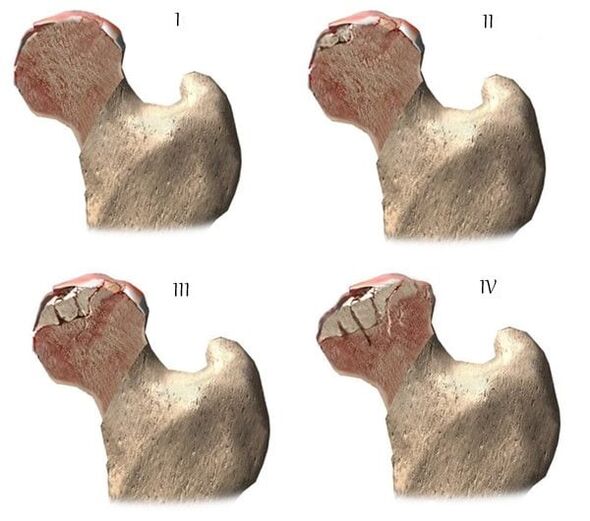
| Degrees | Radiographic signs |
| The first | The changes are not pronounced. Joint lacunae are moderately, unevenly narrowed, there is no destruction of the surface of the femur. Minor bony growths are seen on the outer or inner edge of the acetabulum |
| The second one | The height of the joint space is greatly reduced due to its irregular fusion. The bony head of the femur is displaced upward, deformed, enlarged, its contours become uneven. Bone growths form on the surface of the inner and outer edges of the glenoid fossa |
| Third | There is a complete or partial fusion of the joint space. The head of the femur is strongly expanded. Multiple bony growths are found on all surfaces of the acetabulum |
Diagnostics
When making a diagnosis, the doctor takes into account the clinical manifestations of pathology, anamnesis, the results of an external examination of the patient and instrumental studies. Radiography is the most informative. With the help of her, the condition of the hip joint is assessed, the stage of its course, the degree of damage to cartilage tissues and in some cases the cause of development is established. If the cervico-diphyseal node is enlarged and the acetabulum is oblique and flattened, then with a high degree of probability it is possible to assume dysplastic congenital changes in the joint. Perthes disease or juvenile epiphysiolysis is indicated by the disturbed shape of the hip bone. X-ray may reveal post-traumatic osteoarthritis, despite the absence of a previous trauma in the history. Other diagnostic methods are also used:
- CT helps to detect the growth of the edges of the bone plates, the formed osteophytes;
- MRI is performed to assess the condition of connective tissue structures and the degree of involvement in the pathological process.
If necessary, the inner surface of the joint is examined with arthroscopic instruments. Differential diagnosis is performed to exclude gonarthrosis, lumbosacral or thoracic osteochondrosis. Pain in osteoarthritis can be masked by clinical manifestations of root syndrome caused by nerve entrapment or inflammation. Neurogenic pathology can usually be ruled out with the help of a series of tests. Arthrosis of the hip joint is necessarily differentiated from trochanteric bursitis of the hip joint, ankylosing spondylitis, reactive arthritis. To rule out autoimmune pathologies, biochemical studies of blood and synovial fluid are performed.
Tactics of drug treatment
Medical treatment is aimed at improving the patient's well-being. For this, drugs of various clinical and pharmacological groups are used:
- non-steroidal anti-inflammatory drugs (NSAIDs) - Nimesulide, Ketoprofen, Diclofenac, Ibuprofen, Meloxicam, Indomethacin, Ketorolac. To relieve acute pain, solutions for injection are used, and pills, pills, ointments, gels help to eliminate pain of mild or moderate severity;
- glucocorticosteroids - Triamcinolone, Dexamethasone, Hydrocortisone. They are used in the form of intra-articular blocks in combination with anesthetics Procaine, Lidocaine;
- muscle relaxants - Baclofen, Tizanidine. Included in the treatment regimens for spasm of skeletal muscles, pinching of sensitive nerve endings;
- drugs that improve blood circulation in the joint: nicotinic acid, aminophylline, pentoxifylline. They are prescribed to patients to improve tissue trophism, prevent the progression of the disease;
- chondroprotectors. Effective only in stages 1 and 2 of osteoarthritis.
Ointments with a warming effect help to eliminate mild pain. The active ingredients of the external agents are capsaicin, potentilla, camphor, menthol. These substances are characterized by an irritating, distracting and local analgesic effect. Compresses on the joints with dimethyl sulfoxide, medical bile will help to cope with swelling, morning swelling of the thigh. Patients are recommended classic massage, acupressure or vacuum for coxarthrosis. Daily physical therapy is an excellent prevention of further progression of osteoarthritis.
Surgical intervention
With the ineffectiveness of conservative therapy or the diagnosis of a pathology complicated by ankylosis, an operation is performed. It is impossible to restore cartilage tissue in the joint damaged by arthrosis without prosthetic surgery, but with the right approach to treatment, adherence to all medical prescriptions, maintaining a correct lifestyle, performing exercisestherapeutic, regular massage courses, taking vitamins and proper nutrition, it is possible to stop the process of injury and the destruction of cartilage and hip joints.























